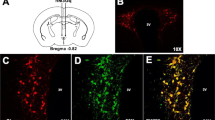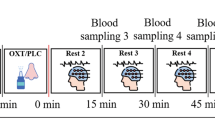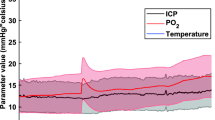Abstract
THE only peptide known which rapidly and consistently elicits a specific behavioural response when injected into the brain is angiotensin II, which in picomole doses causes reptiles, birds and mammals to seek out and drink water1. But, there is evidence to suggest that other peptides such as substance P may also participate in the control of brain function and behaviour. Substance P is distributed throughout the mammalian peripheral and central nervous system, particularly in myenteric plexus, sensory afferent pathways, hypothalamus and substantia nigra2. In the human brain regional concentrations as high as 0.5 × 10−9 mol per g wet tissue have been reported3. Substance P is a member of a family of peptides with similar pharmacological properties and which also includes eledoisin, an undecapeptide obtained from the salivary glands of certain Mediterranean cephalopods4. These peptides share a similar amino acid sequence at the C-terminal end (Fig. 1). Both eledoisin and substance P stimulate nerve cell activity in vertebrates and invertebrates and may act as regulators of neural activity5, but no specific behavioural effect of these peptides has yet been reported. We report here that eledoisin and substance P elicit vigorous drinking when injected into the brain of conscious pigeons.
This is a preview of subscription content, access via your institution
Access options
Subscribe to this journal
Receive 51 print issues and online access
$199.00 per year
only $3.90 per issue
Buy this article
- Purchase on SpringerLink
- Instant access to full article PDF
Prices may be subject to local taxes which are calculated during checkout
Similar content being viewed by others
References
Fitzsimons, J. T. Physiol. Rev. 52, 468–561 (1972).
Leeman, S. E. & Mroz, E. A. Life Sci. 15, 2033–2044 (1974).
Powell, D., Leeman, S., Tregear, G. W., Niall, H. D. & Potts, J. T., Jr Nature new Biol. 241, 252–254 (1973).
Erspamer, V. & Anastasi, A. Experientia 18, 58–59 (1962).
Henry, J. L., Krnjevic, K. & Morris, M. E. Can. J. Physiol. Pharmac. 53, 423–432 (1975).
Evered, M. D. & Fitzsimons, J. T. J. Physiol., Lond. 263, 193–194P (1976).
Johnson, A. K. & Epstein, A. N. Brain Res. 86, 399–418 (1975).
Fitzsimons, J. T. J. Physiol., Lond. 214, 295–303 (1971).
Evered, M. D. & Fitzsimons, J. T. J. Physiol., Lond. 263, 252–253P (1976).
Barker, J. L. Physiol. Rev. 56, 435–452 (1976).
Fitzsimons, J. T. Kidney Int. 10, 3–11 (1976).
Author information
Authors and Affiliations
Rights and permissions
About this article
Cite this article
EVERED, M., FITZSIMONS, J. & CARO, G. Drinking behaviour induced by intracranial injections of eledoisin and substance P in the pigeon. Nature 268, 332–333 (1977). https://doi.org/10.1038/268332a0
Received:
Accepted:
Issue date:
DOI: https://doi.org/10.1038/268332a0
This article is cited by
-
Naloxone treatment attenuates food but not water intake in domestic pigeons
Psychopharmacology (1983)
-
Modifications of drinking behaviour and of arterial blood pressure induced by tachykinins in rats and pigeons
Psychopharmacology (1980)



